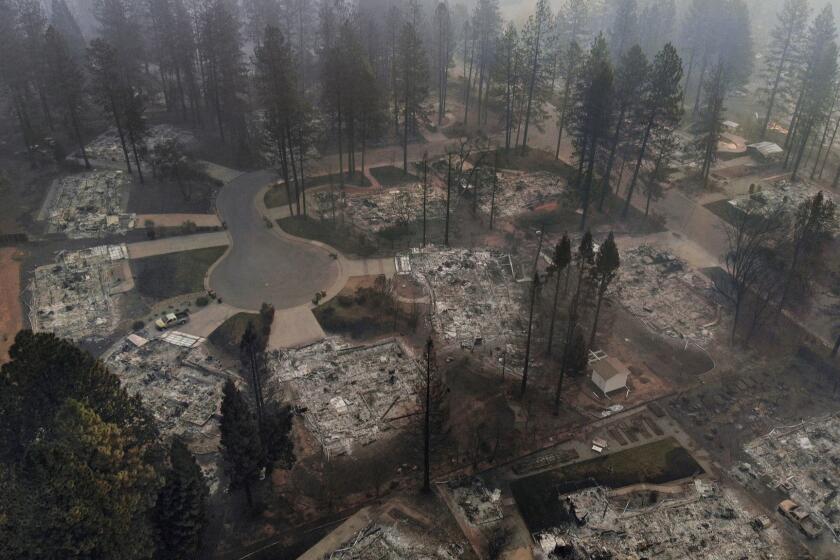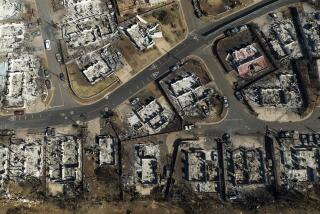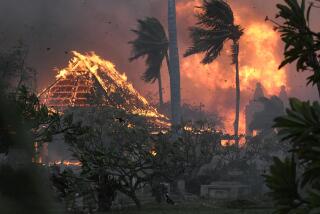PG&E pleads guilty to 84 counts of involuntary manslaughter over Camp fire

In a federal filing Monday permanently documenting its role in causing California’s deadliest wildfire, Pacific Gas & Electric announced it has pleaded guilty to 84 counts of involuntary manslaughter for the 2018 Camp fire in the Northern California town of Paradise.
PG&E, in a filing with the Securities and Exchange Commission, said it reached the settlement with the Butte County district attorney’s office on March 17. Under the deal, PG&E said prosecutors won’t pursue further criminal charges, an outcome that disappointed some utility watchdogs.
This is the second time PG&E’s guilt has been established in a wildfire legal proceeding. In 1997, a Nevada County jury found the utility guilty of causing a fire three years earlier that burned a dozen homes.
But while this chapter of PG&E’s role in the Camp fire is over, the plea‘s implications for other utilities is less clear, said Shon Hiatt, an associate professor of management and organization at USC’s Marshall School of Business.
Hiatt said the plea “is a big thing” not just for Southern California Edison and San Diego Gas & Electric, but for municipal utilities, which could face similar lawsuits for future wildfires.
Such municipal utilities include the Los Angeles Department of Water and Power and the Sacramento Municipal Utility District, among others. They could now be subject to a part of California law, known as inverse condemnation, that mandates utilities are liable for fires their equipment caused, even if the equipment was properly maintained.
“If something were to happen with a city-owned utility, and they were on the hook now? Oh my gosh, you could see bankruptcies,” he said.
To that end, Hiatt said he’d expect to see utilities focus more on preventive work to limit their wildfire risks. Earlier this year, PG&E announced it was spending $2.6 billion each year over the next three years on upgrading and maintaining its grid, Southern California Edison said it would spend $3.8 billion in that time period and San Diego Gas & Electric officials say it will spend up to $1.5 billion.
While they’re working to mitigate those risks, Hiatt said, utilities will probably hire lobbyists to push for lawmakers to revisit inverse condemnation.
“I would be pushing hard for the Legislature to narrow that,” Hiatt said.
In PG&E’s case, however, its culpability in the Camp fire wasn’t just because its equipment caused the blaze, but because it acknowledged failing to properly maintain that equipment. Had it been, the fire may never have happened in the first place.
As part of the plea agreement, PG&E also pleaded guilty to one count of unlawfully causing a fire in violation of the state penal code.
“The Utility will be sentenced to pay the maximum total fine and penalty of approximately $3.5 million. The Agreement provides that no other or additional sentence will be imposed on the Utility in the criminal action in connection with the 2018 Camp fire,” PG&E said in its filing. “The Utility has also agreed to pay $500,000 to the Butte County District Attorney Environmental and Consumer Protection Fund to reimburse costs spent on the investigation of the 2018 Camp fire.”
Investigators with the California Department of Forestry and Fire Protection have concluded that Pacific Gas & Electric equipment sparked the devastating Camp fire that destroyed nearly 14,000 homes and killed 85 people, most of them elderly, last year.
Last year, Pacific Gas & Electric admitted in federal court that its equipment probably caused several wildfires in Northern and Central California, even while it undertook the controversial step of conducting preventative power shutdowns during high-wind events in high-risk fire areas.
“We cannot change the devastation or ever forget the loss of life that occurred. All of us at PG&E deeply regret this tragedy and the company’s part in it,” PG&E Chief Executive Bill Johnson said in a statement. “We cannot replace all that the fire destroyed, but our hope is that this plea agreement, along with our rebuilding efforts, will help the community move forward from this tragic incident.”
Investors seemed buoyed by the news. After a long slide, PG&E‘s stock price jumped more than 12% Monday, to $8.12.
At least one consumer advocate Monday was disappointed that the utility’s executives won’t be held personally responsible.
“You know, if corporations are people as the Supreme Court has suggested, PG&E would be in jail right now. That is normally the penalty for manslaughter,” said Mindy Spatt of the Utility Reform Network, a San Francisco-based ratepayer advocacy group.
“I think from the customer end, it kind of feels like PG&E got away with murder,” she said. “There hasn’t been a lot of accountability.”
The Camp fire, which raced through Paradise in 2018, killed 85 people and destroyed more than 13,900 homes. Both the California Public Utilities Commission and the state Department of Forestry and Fire Protection concluded that poorly maintained PG&E equipment sparked that blaze.
The commission also noted that for years, PG&E failed to do climbing inspections of a century-old tower that malfunctioned, causing sparks where the fire originated. Investigators said there was “visible wear” on the arms of a tower linked to the blaze, but that PG&E crews had not climbed the tower since at least 2001.
Such an inspection could have identified problems with a small metal hook that was supposed to hold up a transmission line and insulator on the tower, and “its timely replacement could have prevented the ignition of the Camp fire,” investigators said.
The omission of climbing inspections on the failed tower “is a violation of PG&E’s own policy requiring climbing inspections on towers where recurring problems exist,” investigators wrote.
In 2016, a federal jury found the utility guilty of violating pipeline safety regulations before a deadly natural gas pipeline explosion in the San Francisco Bay Area and then misleading investigators about how it was identifying high-risk pipelines.
Jurors convicted PG&E of obstruction and five of 11 counts of pipeline safety violations, including failing to gather information to evaluate potential gas line threats and deliberately not classifying a gas line as high risk.
The blast of the PG&E natural gas pipeline in 2010 sent a giant plume of fire into the air, killed eight people and destroyed 38 homes in the city of San Bruno.
More to Read
Sign up for Essential California
The most important California stories and recommendations in your inbox every morning.
You may occasionally receive promotional content from the Los Angeles Times.













